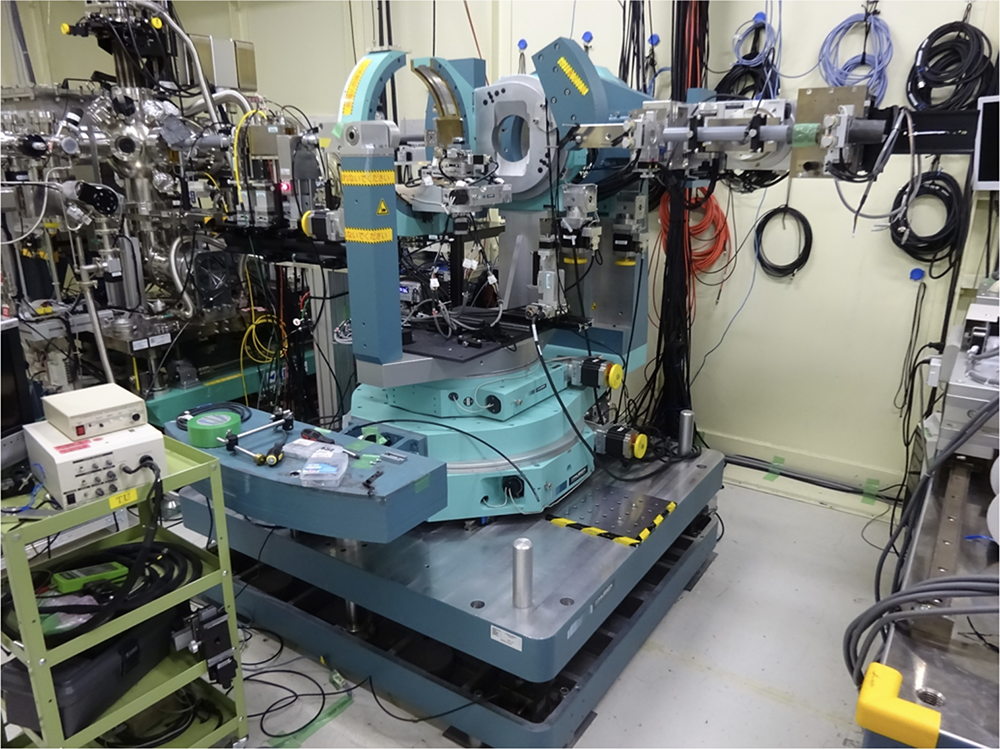BL16XU Versatile six-axis diffractometer
問い合わせ番号
INS-0000001672
The versatile six-axis X-ray diffractometer (manufactured by HUBER) has been developed at BL16XU to meet the diverse analytical needs of both academic and industrial users in the field of X-ray diffraction and scattering. The instrument supports a wide range of applications, including structural analysis of thin films, bulk materials, and functional materials, as well as residual strain analysis and in-situ X-ray diffraction.
The basic configuration of the diffractometer consists of six axes: four sample axes (φ, χ, ω, ωz) and two detector axes (2θ, 2θz). Additional two rotational axes (ωa, 2θa) can be mounted on the detector arm. The χ cradle adopts a C-type (open-type) design to eliminate blind spots during measurement and supports a wide scattering angle range from −20° to 160°. The sample stage can be equipped with an automatic XYZ stage or an automatic swivel stage, allowing for precise sample positioning and mapping measurements of the X-ray irradiation area.
A helium gas exchange sample chamber with a Kapton dome approximately 200 mm in diameter and 50 µm thick is available, which effectively reduces background noise caused by air scattering around the sample.
A motorized 4-quadrant slit on the incident side and two on the detector side (on the detector arm) are available, enabling remote adjustment of the incident beam size and detector-side collimation. Analyzer crystals such as Si(111) and Ge(111) can be mounted on the analyzer stage (ωa, 2θa) located on the detector arm. A solar slit can also be attached to this stage to improve detection efficiency of scattering signals from the broadened illuminated region on the sample surface during grazing-incidence X-ray scattering measurements on thin films and surfaces. The system is also equipped with an automatic attenuator switching mechanism for X-ray reflectivity measurements, allowing acquisition of reflectivity spectra with a dynamic range of up to approximately 1010.
The available detectors include: 0D detectors (LaBr3, scintillation counter), 1D detector (6-module MYTHEN), 2D detector (PILATUS (Si), 300K). In combination with MYTHEN or PILATUS detectors, a variety of experiments can be performed, including time-resolved X-ray diffraction measurements.
SPEC (Certified Scientific Software) is used as the control software for the diffractometer. This command-line-based program enables automated measurements by combining multiple routines using user-defined macros. It also supports automatic sample positioning, allowing for rapid sample exchange.
Figure 2. The 6-axis X-ray diffractometer
Features of the diffractometer
Diffractometer
The six-axis diffractometer manufactured by HUBER consists of 4 axes around the sample (φ, χ, ω, ωz) and 2 detector axes (2θ, 2θz). As well, xs, ys, zs, rxs, rys axes can be attached around the sample and ωa, 2θa axes for mounting analyzer crystals can be installed on the detector axis.
Detector
Depending on the purpose of the experiment, any of the following detectors can be chosen. Both the 0-dimensional detector and the 2-dimensional detector PILATUS 300K can be installed on the detector axis.
- 0-Dimensional Detector: LaBr3 scintillation detector (FMB oxford)
- 1-Dimensional Detector: 6-Fold MYTHEN (DECTRIS)
- 2-Dimensional Detector: PILATUS(Si) 300K(DECTRIS)、EIGER(CdTe) 1M(DECTRIS)
Control Software
SPEC (Certified Scientific Software)is used to control the beamline and the diffractometer.
X-ray Energy
The standard SPring-8 undulator and standard double crystal monochromator (Si (111/311) plane) is used. The available X-ray energy ranges from 6.0~72 keV.
Beam Size
The beam size can be adjusted depending on the measurement objectives.
The maximum beam size is approximately 1.0 mm (H) by 0.7 mm (V).
The minimum beam size formed by slits: approximately 30 µm × 30 µm
Beam Intensity
Under the conditions of 12.4 keV and a beam size of 30 µm (vertical) × 400 µm (horizontal) shaped by slits, the photon flux is approximately 5.0 × 1011 photons/sec.
Other
Multi-axis diffractometers with almost the same specifications as this multi-axis diffractometer are installed in the first hutch of BL13XU and the second hutch of BL19B2, which share equipment accessories and control environments. Depending on the purpose of the experiment, users can choose an undulator source (BL13XU, BL16XU) or a bending magnet source (BL19B2).
Sample Environment Equipment
Automated stage for sample alignment (installed on the multi-axis diffractometer phi-axis)
zs-axis, xs-axis, ys-axis, rxs-axis, rys-axis
The zs-axis is mounted on the phi-axis of the 6-axis diffractometer, and various automatic stages are installed on the zs-axis according to the experimental requirements.
Sample Environment Equipment
- Sample Heating Equipment(Reflection configuration): Anton Paar DHS1100 (Room Temperature to 1100℃)
- Sample Cooling and Heating Equipment(Reflection configuration): Anton Paar DCS500 (-180℃ to 500℃)
- Tensile Testing Machine : Maximum tension load 2 KN, sample size approximately 3 cm (length) × 1 cm (width) × 0.5 mm (thickness)
- Relative humidity control : RIGAKU HUM-01
- Sealed Atmospheric Cell / Gas Environment Cell : Custom-made
Many in-situ experiments using user-supplied equipment have also been conducted. If you are considering bringing your own equipment, please contact the beamline staff before submitting your proposal.
Detector axis optical systems (when using a 0-dimensional detector)
- Double slit
- Solar slit
- Analyzer crystal(Si(111)、Ge(111))
